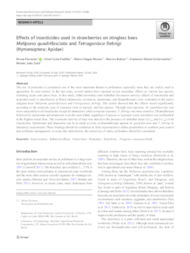Effects of insecticides used in strawberries on stingless bees Melipona quadrifasciata and Tetragonisca fiebrigi (Hymenoptera: Apidae).
Effects of insecticides used in strawberries on stingless bees Melipona quadrifasciata and Tetragonisca fiebrigi (Hymenoptera: Apidae).
Author(s): PIOVESAN, B.; PADILHA, A. C.; MORAIS, M. C.; BOTTON, M.; GRÜTZMACHER, A. D.; ZOTTI, M. J.
Summary: The use of pesticides is considered one of the most important threats to pollinators, especially since they are widely used in agriculture for pest control. In the last years, several studies have reported severe secondary effects on various bee species, including exotic and native bees. In this study, lethal (mortality) and sublethal (locomotor activity) effects of insecticides and acaricides used in strawberries in Brazil (abamectin, novaluron, spinetoram, and thiamethoxam) were evaluated on the native stingless bees Melipona quadrifasciata and Tetragonisca fiebrigi. The results showed that the effects varied significantly according to the pesticide, type of exposure (oral or topical), and bee species. Through oral exposure, M. quadrifasciata was more susceptible to all insecticides except for abamectin, while in topical exposure, T. fiebrigi was more sensitive. Thiamethoxam followed by spinetoram and abamectin were the most lethal, regardless of species or exposure route; novaluron was not harmful at the highest tested dose. The locomotor activity of bees was altered in the presence of sublethal doses (LC10 and LC50) of all insecticides. Spinetoram and abamectin can be as much as toxic as thiamethoxam against M. quadrifasciata and T. fiebrigi in laboratory experiments. These findings should be confirmed in field experiments to define possibilities to combine pest control and pollinator management. In crops like strawberries, the selectivity of native pollinators should be considered. Keywords: Acute toxicity; Behavior effects; Fragaria x ananassa Duch; Native bees; Pesticides; Selectivity.
Publication year: 2020
Types of publication: Journal article
Unit: Embrapa Grape & Wine
Observation
Some of Embrapa's publications are published as ePub files. To read them, use or download one of the following free software options to your computer or mobile device. Android: Google Play Books; IOS: iBooks; Windows and Linux: Calibre.
Access other publications
Access the Agricultural Research Database (BDPA) to consult Embrapa's full library collection and records.
Visit Embrapa Bookstore to purchase books and other publications sold by Embrapa.

